Understanding what can cats eat from the fridge safely can become a bit perplexing, especially when you’re out of cat food.
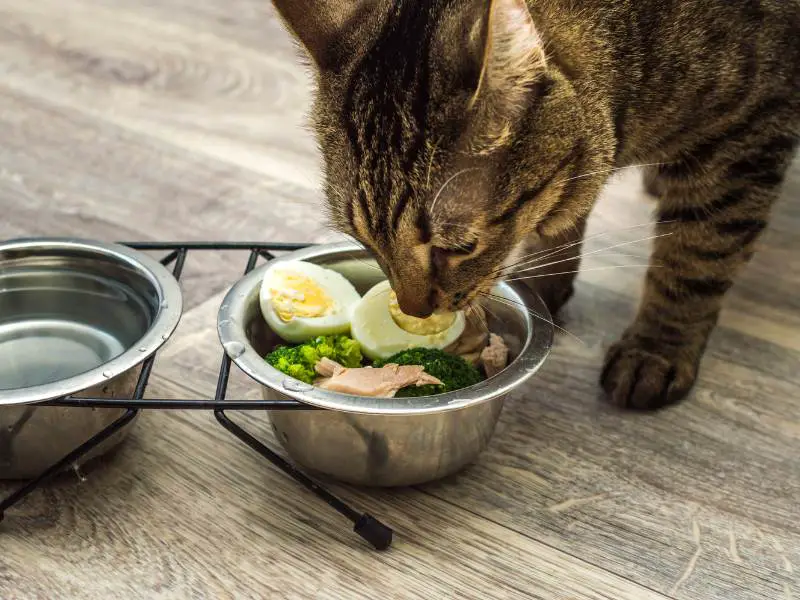
Without clear guidance on cat-safe human foods, the worry of what to feed cats when out of cat food can be overwhelming.
In this comprehensive guide, we’re diving into the topic of “What Can Cats Eat From The Fridge.” From cat food alternatives to suitable everyday human foods, we’ll answer questions like what human food can cats eat, what human foods can cats eat everyday, and what human food can kittens eat.
By the end, you’ll possess the knowledge to confidently feed your cat a variety of human foods without compromising their health. Let’s navigate the world of feline nutrition together for the benefit of your furry companion.
It is also possible that cat food only exists in a particular area and isn’t accessible. Finding food for cats can be challenging in these stressful times.
Moreover, if your cat is on a special diet or is fussy about her eating habits, you may wonder what cat food alternatives you can try. Her favorite cat food brand might also be unavailable due to some reasons.
If you are in a similar situation, we understand that there must be so many questions going through your mind right now. Can cats eat refrigerated food? Can cats eat spoiled food? what can cats eat besides cat food? what human food can kittens eat? The list does not even end there.
You must be wondering if cats can eat canned meat. What foods can cats eat safely? Can cats tell if food is spoiled?
Worry not! We will answer all these questions in this blog!
We have compiled a solution for you. But first, you need to know what you can substitute for cat food. Here, in this blog, we will discuss all the food you can feed your cats from the fridge. Then, you can try the following human foods for your cat:
1. Can Cats Eat Meat?
Yes, cats can eat meat. That’s because meat provides all the important nutrients cats need like protein, amino acids, and taurine. Cats are obligate carnivores, meaning they must have meat to live.
Meat is the primary source of protein in our diets; this is why humans have scavenged animals for meat since the earliest times of recorded history. Hence, meat is a popular food item amongst both animals and humans. Most strong animals eat the meat of relatively weaker animals by hunting them.
You can provide them with different kinds of meat, such as chicken, lamb, turkey, and beef.
It may feel awkward to give meats of such large animals to a small animal. But that is completely fine. Cats typically have no issues eating beef or even mutton. However, thoroughly cook the meat before feeding it to your cat. Cats cannot digest meat if it is undercooked. No raw meats or fish. Raw food can make a kitty sick. Remove all skin and bones from the flesh before feeding it.
2. Can Cats Eat Fish?
Yes, fish can be a seriously delicious and nutritious snack for cats. Did you know fish is chock full of awesome proteins and omegas that are amazing for kitty’s coat and joints?
You might have seen in cartoons that cats love hunting fish. Yet still, do not let your cat hunt fish from someone’s aquarium. Most of the species of fish are safe for your cat to eat. Fish contain omega-3 fatty acids, which are beneficial for the health of cats. Omega-3s help reduce inflammation so joints don’t ache. Those omegas also make fur super soft and shiny.
They are great for cats with kidney diseases. Just like meat, make sure the fish is fresh. Make sure your fish is free from tiny bones before feeding. Just go slow and watch for bones. And make sure fish is part of a balanced diet along with cat food, not the sole source of nutrition.
Another additional reminder is that stray cats are typically different from domestic cats. For example, stray cats might be able to digest undercooked food more quickly than domestic cats. But, if you are feeding either, make sure you provide them with thoroughly cooked fish or meat.
3. Can Cats Eat Rice?
Yes, cats can eat rice. While it’s not a necessary nutrient, rice can be an okay occasional addition to a kitty’s diet. You can never go wrong with rice. Rice has to be one of the most easily digestible foods known to man. Human beings eat rice in several forms. But while feeding rice to cats, make sure you are providing simple rice to them. Put only a few sauces or spices before feeding rice to the cat.
There is still a big question mark whether those sauces or condiments would be okay for the cat. So, for this reason, avoid putting anything that puts you in doubt—ideally, feed plain rice to your cat.
4. Can Cats Eat Eggs?
Yes, cats can eat eggs, but only in moderation and always cooked. While a great protein source, eggs should only be an occasional treat for cats due to their high-fat content. As an obligate carnivore, your furry friend gets plenty of protein from meat. Hence, eggs are a healthy treat. However, avoid feeding raw eggs to your cat due to the risk of salmonella.
Some important things to keep in mind:
- Limit eggs to 1-2 times per week max to avoid weight gain.
- Cats with medical conditions may need to avoid eggs – check with your vet.
- Egg whites alone lack fat and shouldn’t replace meat-based meals.
- Eggs shouldn’t become a staple food.
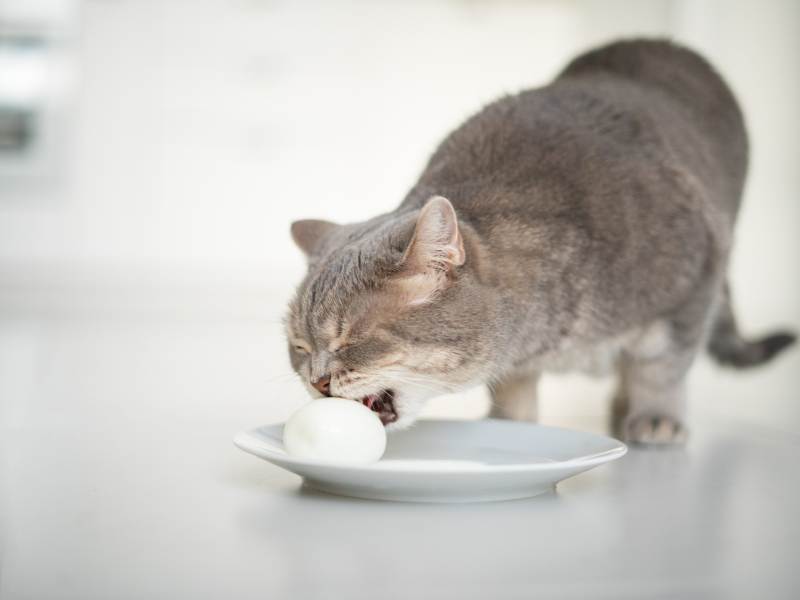
5. Can Cats Eat Vegetables?
Yes, Cats can eat vegetables. But it is common for cats to hate vegetables. When you present vegetables in front of cats, they might get annoyed. However, not all cats hate veggies. If your cat loves veggies, then your cat is bound to stay healthy. They offer a lot of fiber and vitamins.
Eating vegetables can save the cat from being dehydrated even if the cat does not drink any liquid. Cucumbers, Peas, and Broccoli are safe vegetables for cats.
6. Can Cats Eat Fruits?
Yes, Fruits are safe for cats to eat. But fruits can also be a hit-and-miss, just like vegetables. Ironically, cats and infants are the same when eating fruits. You cannot feed all of the fruits to them; some might love them, while others may hate them. For example, if your cat has a sweet tooth, it may love eating fruits.
On the other hand, if your cat does not like sweets, it will probably not love fruits. However, many fruits contain Vitamin A and Vitamin C. Bananas, Blueberries, Watermelons, and Pumpkins are the fruits cats can eat.
Curious about Cats and Bacon? Everything You Need to Know About Whether Cats Can Eat Bacon Safely.
7. Can Cats Eat Cheese?
Yes, cats can eat cheese in moderation. Cheese has got to be one of the most beloved food items in the world. You cannot possibly say no to a slice of cheese. Just like humans, cats are fond of cheese. Cheese is high in calcium and protein.
It’s best not to share table scraps daily since dairy can upset a kitty’s tummy. Felines lack the lactase enzyme to fully break down lactose in milk products. Some signs your cat ate too much cheese include puffed fur, vomiting, or diarrhea. Also, steer clear of super salty feta or processed cheese slices.
Therefore, it is healthy for cats. You can feed cheese to your cats at any time. You can give cheese in multiple safe forms.
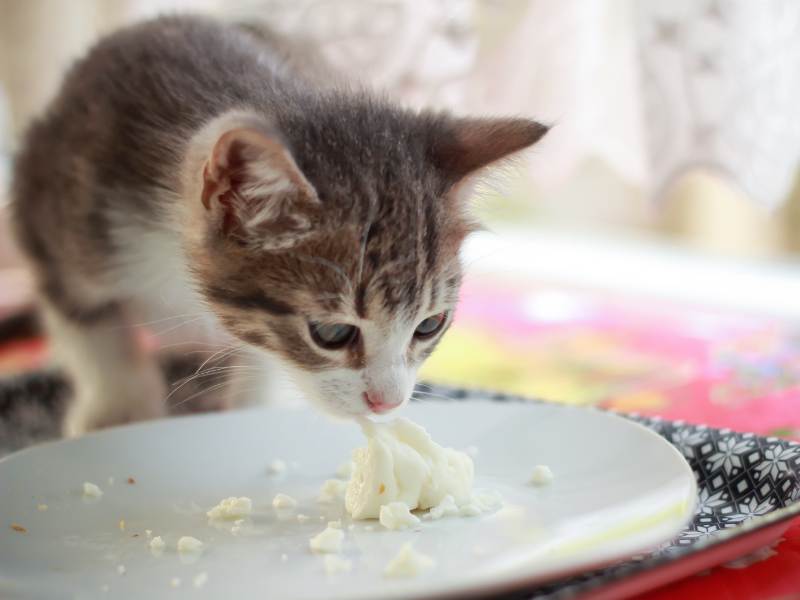
8. Can Cats Eat Bananas?
Yes, cats can eat bananas in small portions. Bananas are one of the healthiest fruits to exist. Bananas deliver glucose for energy without extra calories and potassium to support heartbeat & muscle function
A few tips when giving Fido a taste of a banana:
- Peel it first since the skin is tough for kitties to digest.
- Cut into teeny bites they can comfortably chew.
- Go slow when introducing new human foods.
- Watch closely for tummy troubles like vomiting
However, being one of the healthiest fruits, you can feed bananas to your cats without having to worry about anything. You can even mash the banana to make it easier for the cat to eat.
9. Can Cats Eat Oatmeal?
Yes, Cats can eat oatmeal. Oats have a lot of fiber, iron, and protein. All of these are important for the health of your feline. Oats can also be beneficial for the skin of cats.
Oatmeal does offer some perks like:
- Protein and skin-healthy fats support coat condition
- Soothing-soaked oats can relieve itchy skin issues
Here are tips for giving kitty oats:
- Serve small amounts mixed into wet food, not dry plain oats
- Use water instead of milk since some cats are lactose intolerant
- Introduce new people foods gradually to watch for reactions
- Oatmeal shouldn’t replace meals – keep portions tiny
Too much oatmeal could upset a kitty’s carnivore digestion. And some fussy felines may refuse it outright.
10. Can Cats Eat Spinach?
Yes, most cats can eat spinach. Spinach is a healthy food item. It is rich in many nutrients, including vitamins A and C, Potassium, iron, etc. In addition, feeding spinach to your cats can give them a lot of energy so that your cat can spend the whole day teasing you and running all over your place.
Spinach offers some supplementary vitamins and minerals, such as:
- Vitamins A, K, and folate for skin and vision
- Magnesium for muscle function
A few precautions when sharing spinach:
- Avoid for cats prone to bladder stones – talk to the vet
- Offer as a tasty topping, not the main part of a meal
- Limit other treats to no more than 10% of daily calories
Cats’ digestive systems are designed for protein, not greens. And some kitties just won’t touch leafy veggies at all.
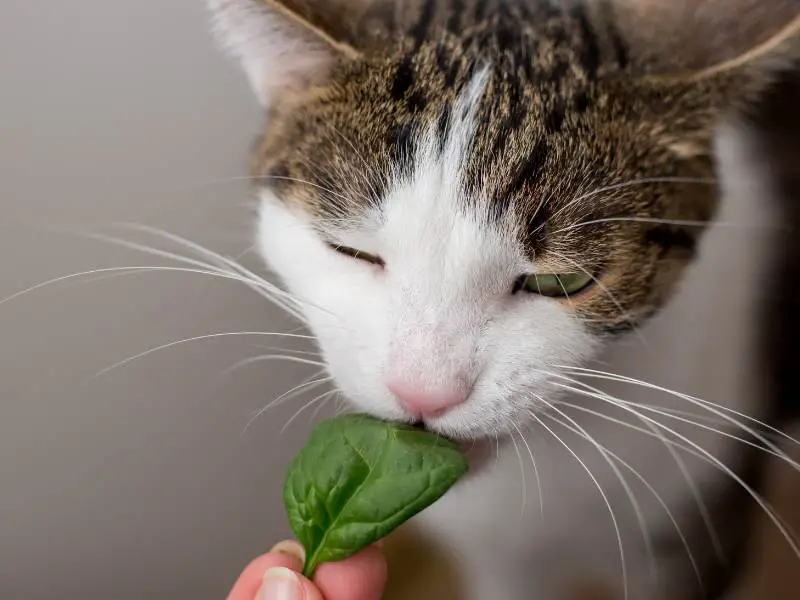
11. Can Cats Eat Pumpkin?
Yes, cats can eat plain pumpkin, but it should only be given as a treat. While pumpkin flesh provides beneficial fiber and nutrients, it should merely be an occasional snack, not a regular part of a kitty’s diet. As obligate carnivores, cats get their nutrition mainly from meat and cat food.
Some pumpkin perks when given sparingly include:
- Prebiotic fiber to keep bellies regular
- Vitamins and minerals in light dosage
Guidelines for pumpkin treats:
- Only plain canned pumpkin, no additives like pie fillings
- Nothing but the veggie flesh – avoid stem, skin, pulp
- Small amounts based on kitty size – 1/2 tsp max for little ones
- Too much could cause tummy trouble instead of relieving it
- Always check with your vet
Pumpkin makes a great supplement now and then, but an all-meat diet featuring quality wet food remains crucial for feline health.
Ever wondered if your cat knows what you’re saying? Read our blog post to find out!
12. Can Cats Eat Cantaloupe?
Yes, cats can eat cantaloupe. While not integral to feline diets, small amounts of cantaloupe can occasionally be an okay treat for most kitties. Its natural protein scent may attract cats, and it offers modest amounts of vitamins and fiber.
Guidelines when sharing melon:
- Plain flesh only – avoid rind, seeds which could cause blockages
- Cut into tiny bite sizes
- Limit to infrequent, small portions as part of a balanced meat-focused diet
13. Can Cats Eat Carrots?
Yes, cats can eat carrots. While not a natural part of their carnivorous diet, cooked carrots provide some modest benefits for cats when given sparingly. Meat must always be the main component of a kitty’s nutritional needs.
Carrots offer:
- Vitamin A for eye & skin health
- Fiber for digestive regularity
When sharing carrot sticks:
- Cook thoroughly, then cut into teeny pieces to avoid choking
- Limit quantities and avoid as a regular meal addition
- Watch carefully for signs of tummy trouble in sensitive kitties
Cats lack the full ability to digest plant material. Their stomachs are designed for animal proteins instead of fibrous veggies.
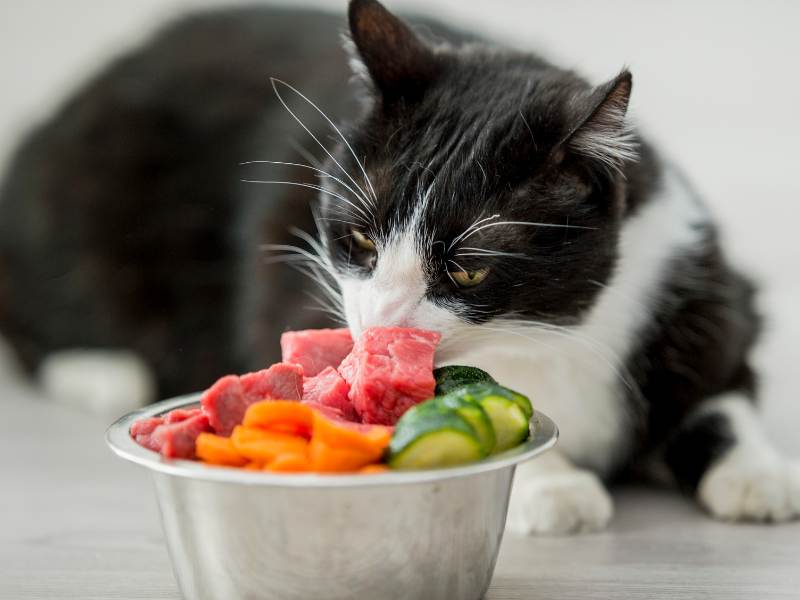
14. Can Cats Eat Blueberries?
Yes, cats can eat blueberries in small quantities as an occasional treat. While tasty, blueberries require moderation for cats due to their high sugar content. As obligate carnivores, berries are a novelty item rather than a staple treat. But you can feed blueberries to your cat when you’re out of cat food.
Blueberries offer antioxidant perks in small portions such as:
- Vitamins C, E, and fiber for overall health and digestion
Guidelines when sharing:
- Tiny cut pieces to avoid choking – avoid skins that may upset tummies
- Limit to occasional fun supplements, not a regular snack
- Watch closely for diarrhea or belly upset in sensitive kitties
Too many sweet berries could spike blood sugar in diabetic cats or cause digestive distress. Always check with your vet about dietary changes too.
Small, infrequent blueberry bites may delight your curious kitty. But an animal protein-focused diet including balanced cat food must remain the primary fuel source for feline nutritional needs and natural carnivore digestion. Moderation makes all the difference when giving any people foods as occasional extras.
15. Can Cats Eat Peas?
Yes, cats can eat peas. Peas is one of the human food cats can safely eat. While not a natural part of their diet, small amounts of cooked peas can sometimes be an okay occasional snack for cats. As obligate carnivores, meat should make up the bulk of kitty’s nutrition.
Peas deliver some vitamins like:
- Vitamin A for eyes and skin
- Vitamin C to support the immune system
When offering pea treats:
- Remove pods that pose a choking risk
- Cook peas thoroughly to reduce phytates rare beans can sometimes cause issues for sensitive kitties
- Limit to infrequent, tiny portions only as a supplement – not a replacement for balanced cat food
Some felines just won’t enjoy legumes at all either. And uneaten peas provide no value to kitty’s diet versus meat-based proteins.
Provided your vet gives the thumbs up, small tastes of carefully prepared peas mixed into meals may enrich the kitty’s diet a bit. However, pea pods or too many beans could potentially cause stomach upset in some cats. Meat-focused cat nutrition must always take top priority for feline health needs.
Thinking about getting a pet? Read our blog post to learn why adopting is the best option!
16. Can Cats Eat Yogurt?
Yes, cats can eat plain and unsweetened yogurt. While dairy isn’t a natural part of their diet, plain yogurt occasionally makes a healthy snack for cats able to handle lactose. As obligate carnivores, meat should remain the focus.
Yogurt benefits include:
- Prebiotic probiotics aid digestion when eaten sparingly
When sharing yogurt:
- Plain Greek or regular styles only – avoid added sugars or flavors
- Go slowly introducing dairy to watch for tummy reactions
- Limit portions, as yogurt is high in fat compared to kitty’s needs
Most cats lack enzymes to fully break down lactose. And some kitties are outright dairy-intolerant.
Rather than frequent yogurt snacks, feline nutrition is best centered on meat-based protein. Yogurt can enrich the diet of lactose-tolerant cats as long as portions stay tiny. But monitor reactions closely and check with your vet regarding specific dietary parameters too. Meat must take priority in any kitty’s species-appropriate carnivore diet.
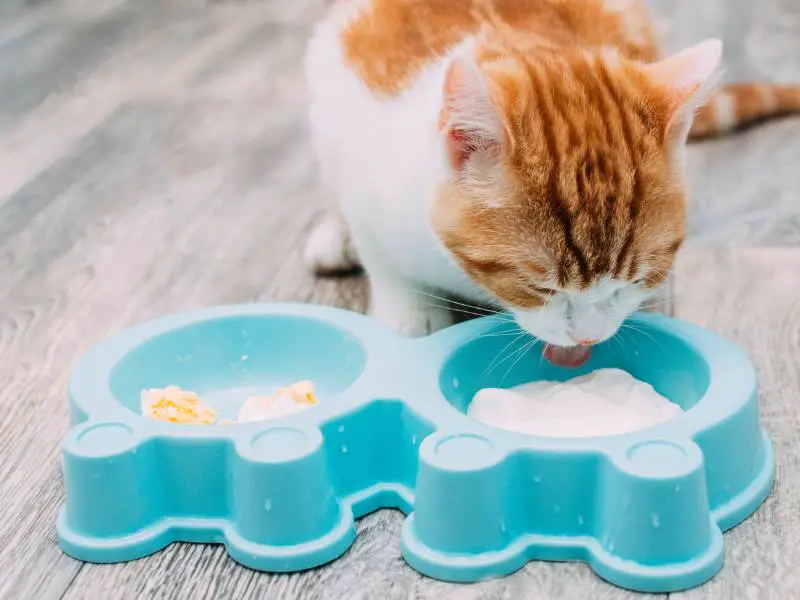
17. Can Cats Eat Apple?
Yes, cats can eat apples in small amounts as an occasional treat. While lacking nutritional importance for cats, small bits of apple now and then can be an acceptable treat. As obligate carnivores, meat is what kitty requires for optimal health.
When sharing apple slices:
- Remove seeds, cores, stems, and skin which could upset tummies
- Cut into sliver-thin pieces to avoid choking risk
- Only offer infrequently in tiny portions, not regularly
Fruits naturally lack what cats need as carnivores versus meat-based cat food. And some felines just aren’t interested in human food at all.
Apples provide minimal vitamin supplementation safely consumed sparingly. Expect no enrichment value greater than that of kitty’s normal diet.
When introducing any new human food, go slowly and closely monitor reactions. With vet guidance, apple pieces on rare occasions may delight your curious cat if tolerated. But nutritious cat cuisine designed for carnivore needs always takes dietary priority.
18. Can Cats Eat Broccoli?
Yes, cats can eat broccoli in moderation. While not a natural part of their carnivorous diet, small amounts of broccoli can be tried cautiously as an occasional supplement for some felines. As meat-eaters, protein is crucial for kitty.
Broccoli provides modest perks like:
- Antioxidants that may support immune function
- Fiber for gut health
Guidelines when introducing broccoli:
- Start with a single cooked floret to test tolerance
- Limit quantities, as fiber fills the kitty up from meat intake
- Watch closely for digestive issues in sensitive pets
Cats lack the full ability to process plants nutritionally. And stressed stomachs may reject new foods.
For adventurous kitties tolerating tiny tastes, broccoli makes a low-caliber treat. But meat-rich meals must take priority in species-appropriate carnivore diets. Vet guidance is wise when trialing any new people foods. Moderation protects our furry friends best.
Concerned about your cat’s sudden silence? Read our blog to uncover the reasons behind their quiet demeanor.
19. Can Cats Eat Grains?
Yes, cats can eat grains. While carnivores by nature, some grains can be included occasionally in small amounts for cats. However, grains should never comprise the main component of their diet.
As felines, cats lack full digestive enzymes to break down plant matter. Their systems evolved to process meat instead of botanicals.
Some grains offering modest nutrients include:
- Brown rice – fiber, vitamins
- Oats – protein, skin-healthy fats
- Quinoa – protein, antioxidants
Guidelines for grain snacks:
- Tiny portions mixed into wet food, never replacing meat meals
- Whole grains over refined for more nutrients
- Watch closely for tummy troubles in sensitive kitties
Digestive issues, weight gain, or nutrient deficiencies could result from excessive grains lacking animal proteins cats require.
For adventurous eaters tolerating grains, tiny samplings provide little dietary value beyond meat-based cat food. Overall feline health depends on meat-centered nutrition as nature intended. Consistency protects our carnivorous companions best.
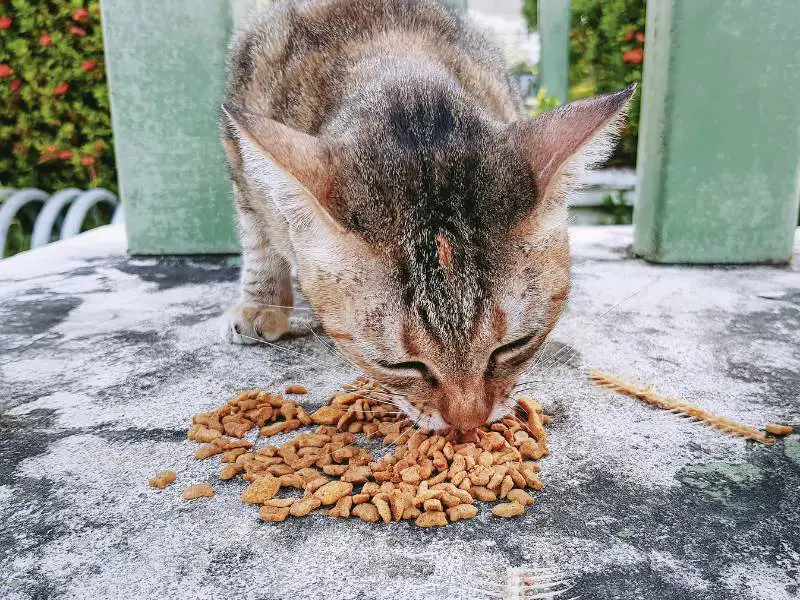
What Can Cats Eat Besides Cat Food?
Here is a list of human foods cats can eat safely that you can consider including in your cat’s diet. Always introduce new foods gradually and monitor for any adverse reactions:
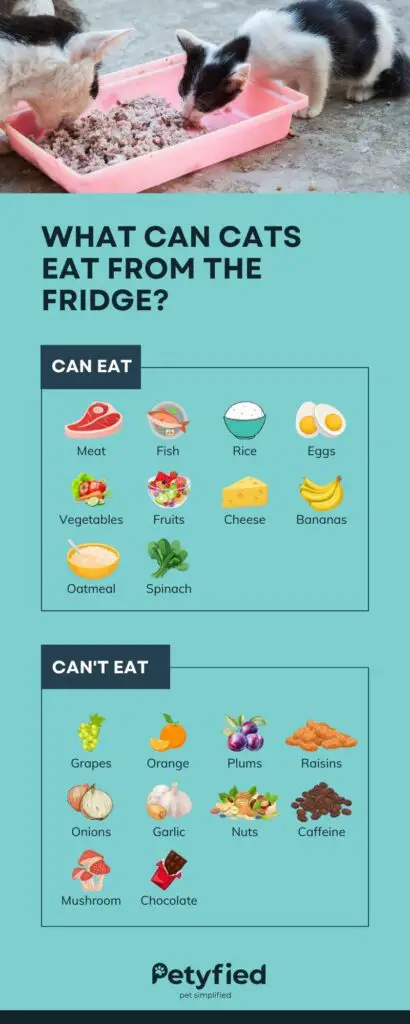
- Cooked Chicken
- Cooked Turkey
- Cooked Beef
- Cooked Salmon
- Cooked Tuna
- Cooked Pork
- Cooked Lamb
- Eggs
- Plain Rice
- Plain Quinoa
- Cooked Pasta
- Pumpkin
- Carrots
- Peas
- Sweet Potatoes
- Blueberries
- Strawberries
- Watermelon
- Cantaloupe
- Spinach
- Broccoli
- Zucchini
- Cucumber
- Cheese (in moderation)
- Yogurt (plain, no added sugar)
- Small amounts of Milk
- Plain Oatmeal
- Plain Popcorn (no butter or salt)
- Green Beans
- Apples (seedless and core removed)
- Bananas
- Mango
- Pineapple
- Bell Peppers (in moderation)
- Cranberries
- Peaches (no pit)
- Apricots (no pit)
- Asparagus
- Brussel Sprouts
- Celery
How to Feed Cats
- No matter what you feed the cats from the fridge, you must give them an adequate portion.
- Do not give large portions of any human food to your cat. If you want to go into detail, feed at most 20 calories daily. It would be equivalent to two teaspoons of cooked chicken or salmon.
- You can mix and match safe human foods to reach the number of 20 calories. However, if you exceed the number, the food could harm your cat.
- If your cat is gaining weight due to excess calories, then you should lower it. Then, give the necessary amount of calories to your cat.
- If you are serving any sweet food item for the first time, such as fruits, you should always give a small portion to the cat first because you might need to find out whether the item will suit the cat.
- Stomach issues are common when you feed something new to a cat. Just make sure that the item does not harm the cat too much.
- If the food item suits the cat, then you can choose to feed it again to the cat.
- Ensure that your kitty is receiving proper nutrients daily. Otherwise, the kitty will stay tired the entire day.
What Can Cats Not Eat?
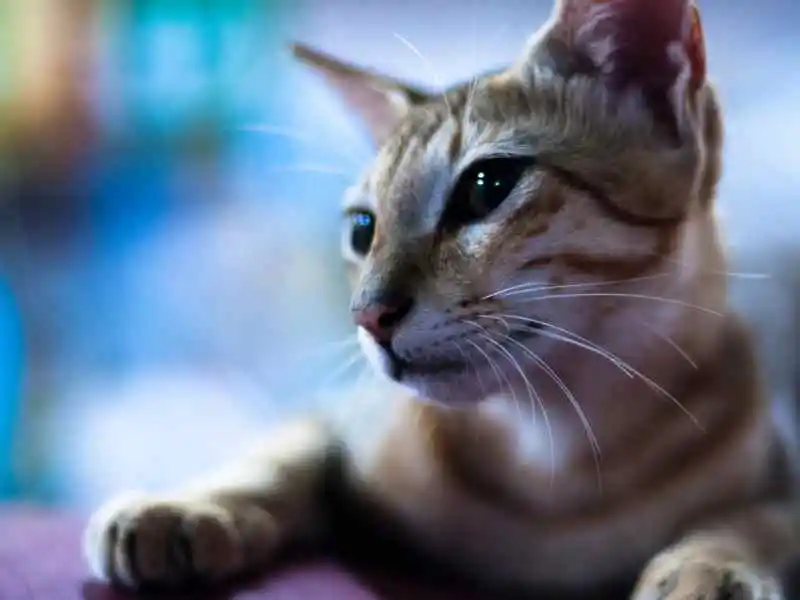
Since we have covered what cats can eat from the fridge, we will focus on what cats should not eat. Many foods are not suitable for cats. Let’s start with a list of fruits that cats must avoid:
- Grapes
- Oranges
- Plums
- Raisins
Just like fruits, cats should avoid several vegetables. Some are the following:
- Onion
- Garlic
- Mushroom
Several other food categories are also not suitable for cats. Nuts are one of them, even though they are not entirely poisonous for cats. If cats intake nuts in large amounts, it can cause diarrhea. Meanwhile, caffeine is also not suitable for cats. Any food or drink containing caffeine is a straight no.
Key Takeaways
You need to know all the food you can feed your cat if you run out of cat food. It depends on the nature and suitability of your cat. There’s a probability that your cat might feel uncomfortable with only some of the food items mentioned above. In such a case, avoid those foods at all costs.
On the contrary, there is also a probability that your cat may feel suitable with almost anything you feed it from the fridge. Of course, you should not take this risk, but if you do, check whether providing that food item to cats is safe. Here are some other significant takeaways about this issue.
- Most food groups contain a few items your feline companion can safely consume. Similarly, these food groups also have things you should never feed, such as chocolate and wild mushrooms.
- Call your veterinarian for advice if you suspect your pet has ingested contaminated human food. Small amounts might not cause harm in some cases, but larger quantities may require urgent treatment. Make sure that food item is not fed to your cat again.
- Remember that human foods should be given as an occasional treat and shouldn’t make up more than 10% of your cat’s daily calorie intake.
Conclusion
It would be best if you first relied on cat food for the feeding process of cats. Therefore, it is better to avoid human food if you have a variety available of cat food. You can always make safe choices if you cannot prevent human food.
The secure options will always work. Digestion systems for cats can be sensitive. Hence, always ensure you are giving clean food items to your cats. Whatever you do, provide only suitable food to your cats.
Do not experiment with your cats at all. The well-being and health of your cat should be your top priority. Only feed it with the best food products available. But then again, it also depends on what suits your cat. If something fits your cat, keep giving it. If something doesn’t work for the cat, keep that item miles away from it.
